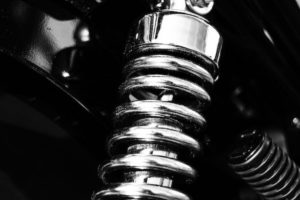Quick Navigation
When driving, your car might develop weird behaviors such as wobbling when hitting bumps.

It is not usual for your car to wobble when hitting bumps, so take immediate action to determine the cause and the solutions to this problem.
Various car issues can result in this behavior. Engine, wheels, and axle issues are some of the notorious causes. It is thus not easy to determine the actual cause.
Anytime you feel wobbling when hitting bumps, take your car for a thorough mechanical check-up.
Reading this guide will enlighten you on the causes and possible solutions.
Causes & Solutions
Various issues can make your car wobble when passing over bumps. Here are the common causes and the possible solutions.
Faulty Struts
Struts are part of the suspension system within the shock absorbers. Their primary role is softening the shock absorbers as you drive over various road conditions.
The softness enables the shocks to handle rough terrains effectively. Therefore, protecting the body of your car from road damage.
The struts make it easy to handle your car when driving because it improves stability while in motion.
Their role exposes them to tear and wear. Whenever they become faulty, your car will have weird behavior.
Typically, it will wobble whenever you hit bumps.
Apart from feeling wobbles, faulty struts can increase your stopping distance during the rainy season, and your car will tip when making a turn when accelerating, the rear end might squat, and also unusual tire wears.
Solution
As soon as you notice your struts are faulty, consider replacing them. You can do it alone or seek the services of a professional mechanic.
The struts are integrated with the springs, which makes them dangerous when not properly removed.
It is, therefore, essential to use a spring compressor to remove it safely. You can buy or rent a spring compressor.
After assembling the necessary tools, use a jack to raise your car. After doing this, consider putting the jack stand just behind the front wheels.
Doing this will enhance safety and stability.
Remove the wheels to access the struts. Use the spring compressor to loosen the bolts holding the struts.
After successfully removing the faulty struts, install the new ones. Tighten all the bolts after performing this procedure.
Take your car for a road test and be keen on how it behaves.
Bad Bearings
Wheel bearings are an essential part of the wheels that many car owners forget about when they take their cars for scheduled maintenance.
The bearing enables the wheels to rotate smoothly.
The bearing can sometimes be loose or worn out. In such a situation, your ride will no longer be smooth.
You will feel wobbles whenever you hit bumps. Bad bearings will also interfere with your steering wheel, making it shaky whether you are driving at low or high speed.
Solution
You will need to check the condition of your bearings. Doing this is a challenging task following their location.
You can use an automotive stethoscope to check your bearings. First, you have to suspend your car using a jack stand.
Ensure the tip of the stethoscope is close to the bearing. Ask your partner to step on the gas pedal until the speed reaches 40 mph. As this happens, listen to any noise.
Other accurate methods are the use of hands and shake tests. When these tests reveal that your bearings are faulty, consider buying new ones and fixing them.
Worn-Out Control Arm

Control arms are at the front axle of each wheel. The control arm is commonly made of cast iron, aluminum, or steel.
The control arm lets the wheel and the chassis move in unison, thus enhancing your car’s stability in motion.
It enhances proper coordination between the suspension and the steering system.
The control arm takes the most impact and stress, which facilitates the rate at which it wears out.
But the speed of wearing out varies depending on where you drive regularly.
The control arm has various parts, such as the bushing, ball joint, and frame, that wear out more often.
Solution
First, you need to inspect the extent to which your control arm is worn out. To do this, you will need to lift your car.
If the lower arm is worn out, consider inspecting the condition of the upper arm.
If only a single control is worn out, replace it while budgeting for the other arm. But replacing both arms from the same side is ideal.
You can replace the control arm at home or seek the services of a professional mechanic. The task can be overwhelming, so it is essential to have a helper.
Wheel Problems
Wheel problems such as wrong tire pressure, bent rims, and poor wheel alignment can lead to car wobbling when you hit bumps.
Driving on rugged terrain or hitting potholes can bend your rims.
Front wobbling indicates that the front rim is bent, but if you feel the wobbling behind you, either rear rim is bent.
Tire manufacturers recommend the correct tire pressure. Low tire pressure leads to poor contact between the tire and the road.
In such a situation, you will experience a shaky and bouncy ride. It can also result in uneven tire wear.
The wheels should align with the body of your car. If not, there will be poor contact between the wheels and the road.
Poor wheel alignment leads to vibrations when passing bumps. Apart from car wobbling, your car will pull sideways when driving, and also you will have uneven tire wear.

Solution
Depending on the type of rim your car uses, you can realize that they are bent or cracked during the inspection.
Sometimes you can only see bends on your rims if you go to a professional for an inspection.
The professional will fix bent rims using a special machine. You can mend cracked rims, but it will depend on the degree of crack.
Poor tire pressure can interfere with the handling of your car. It is, therefore, necessary to ensure that your wheels have the correct tire pressure before you start driving.
This is an easy inspection and service you can perform at home.
If you need help with the correct tire pressure for your car, seek advice from your mechanic or check your car’s manual guide.
Visit your mechanic to perform wheel alignment.
It is essential to align your wheels whenever you fix new tires or repair the existing ones and whenever you service the brake pads or the suspension system.
Takeaway
Car wobbling when hitting bumps is a problem you might ignore but can escalate into serious issues that might be costly to repair.
Therefore, inspecting your car whenever you feel vibrations when passing bumps is necessary.
Common causes are wheel problems and faulty suspension systems.
You can fix some of these causes, but you will need to seek the services of a professional mechanic.
When wobbling persists, fixing the issues may be hectic, and buying a new car can be the best option.
But what if your budget is limited? This guide has outlined the common causes and solutions to car wobbles when hitting bumps.

Kevin has been hanging around cars and automobile magazines since he knew what a car is. He grew up in his father’s 1995 Mercedes E320 Wagon and Volkwagon Phaeton W12 2004. He rides his first car, a manual 1979 Porche 911SC.
Currently, he owns an Acura Integra GS-R. During his childhood, he showed a keen interest in how things actually work and fix them. This passion transforms into his eternal love for cars and bestows him an ideal position in one of the leading automobile companies; whenever he finds time, he takes out his Acura and opts for the longest possible route to find hidden wholesome pleasure in a road trip.
Want to read some of the articles written by Kevin? Head to our blog section to find out all the articles written by Kevin.







